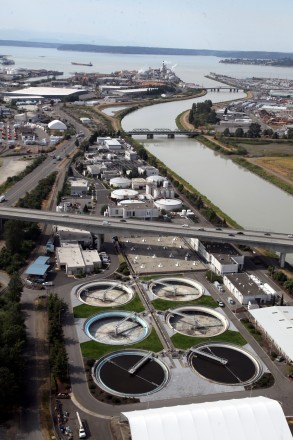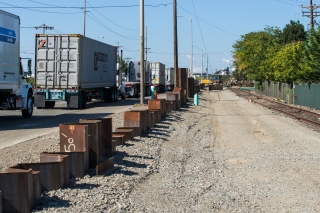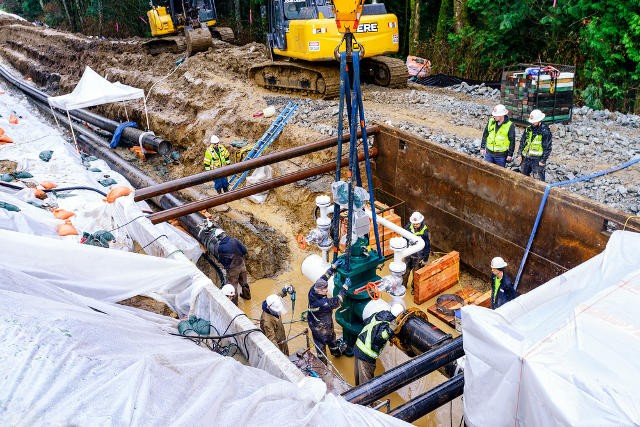TACOMA TREATMENT PLANT ADDS WALL AND GATES TO BLOCK FLOODS
Seattle DJC, Daily Journal of Commerce, By Journal Staff

Photos from the city of Tacoma [enlarge]
- FloodBreak gates lie flat on the ground, but pivot up on a hinge when water flows into them and get locked in place by the weight of water.
The Central Wastewater Treatment Plant in Tacoma can treat about 135 million gallons of wastewater a day and send it into Commencement Bay, but its location near the Puyallup River makes the plant one of the highest flood risks in the region.
The plant on East Portland Avenue flooded in 1996 when tide gates failed on the stormwater outfall system. Then in 2009, the city had to pull crews off other projects so that they could quickly fill and stack sandbags around the plant when flood waters came close.
If floods inundate the plant, raw sewage could be released into the bay.
This worried officials from the city and Pierce County so much that they came up with $8.7 million to build 2,500 feet of floodwalls around the low-lying northern and southern portions of the plant site.
A $6.1 million contract for the floodwalls was awarded earlier this year to Ferndale-based Imco General Construction, the lowest of seven bidders for the job.
Imco crews are finishing installation of the northern wall's sheet piles and just started work on the taller southern wall. Work is about half done and should wrap up in January 2015.
The sheet piles extend as much as 25 feet into the ground to block underground seeping. Imco is vibrating piles into the earth and configuring them so that each edge nests with the next to create a watertight seal.
Floodwalls will be made from about 1,250 steel piles and extend as much as 8 feet above the ground. The east and west parts of the site are built up and don't need floodwalls.
The city says the project includes three hydrostatic lift gates that will be the first of their kind in the state. The automatic gates were invented by FloodBreak of Houston following tropical storm Allison in 2001.
FloodBreak's gates are buoyant panels built with hollow aluminum extrusions and self-sealing rubber gaskets. They are up to 6½ feet tall and 35 feet long. The panels sit flush with the ground, but when water flows into them they pivot upward on a hinge. The gates continue to rise until they reach a 90-degree angle, and get locked in place by the weight of the water.
A video showing how the gates work is at http://tinyurl.com/FloodBreak.
The gates are expected to be installed later this month. Crews will also install two manual gates, relocate utilities and build a new pump station system.
The treatment plant was built in 1952 and has had three major upgrades — the last was in 2009 and was intended to meet peak wet weather flows.
CH2M Hill is the project designer and KPG assisted with the floodwall aesthetics. Northwest Hydraulic Consultants is verifying floodwall heights.
The project is funded by about $6 million from the Pierce County Flood Control Zone District and $2.7 million from city utility fees.
Copyright 2014 Seattle Daily Journal of Commerce
Link to DJC article: http://www.djc.com/news/co/12069786.html
Link to IMCO project page: http://www.imcoconstruction.com/project/tacoma-central-treatment-plant-flood-protection




